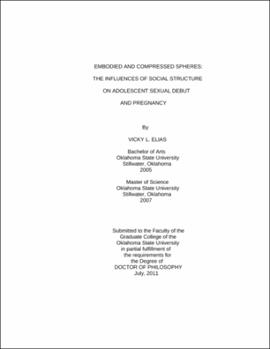| dc.contributor.advisor | Van Delinder, Jean | |
| dc.contributor.author | Elias, Vicky L. | |
| dc.date.accessioned | 2013-11-26T08:28:00Z | |
| dc.date.available | 2013-11-26T08:28:00Z | |
| dc.date.issued | 2011-07 | |
| dc.identifier.uri | https://hdl.handle.net/11244/6999 | |
| dc.description.abstract | Scope and Method of Study: In this research, data from Waves I and II of the National Longitudinal Study of Adolescent Health (Add Health) were used to test predictions based on a synthesis of the theories of Michel Foucault and Peter M. Blau. Using this synthesis, I propose that society is hierarchically arranged such that those in higher social positions will have access to a wider range of spheres of power while those in lower social positions will have access to a more constrained range of spheres of power. Using Foucault's conceptualization of power as an emergent process based in knowledge and discourse, I further propose that as the range of spheres of power to which an actor has access (today or in the anticipated future) is constrained, the probability that power will be exercised in any available sphere is increased. The body is a sphere of power that cannot be separated from the actor, and thus those teens with a constrained range of spheres of power are more likely to exercise embodied power through sexual behaviors. As a social institution, schools are expected to replicate and reinforce social hierarchies and are thus expected to influence teen sexual behaviors such as debut and pregnancy, which serve as my dependent variables. Analyses were completed using multilevel discrete time hazard analysis and sequential logit models. Nine hypotheses are proposed and tested. | |
| dc.description.abstract | Although findings addressed in the hypotheses were mixed, clear indications of the role of schools as predicted by the proposed theory were found. Schools exert an influence on adolescent sexual behavior, particularly among younger teens. Intraclass Correlation Coefficients indicate among teens under the age of sixteen, eight percent of variance in sexual debut is due to schools. School level variables associated with debut include the proportion of the faculty that is black and being a rural school. School size and being a public school were significantly associated with pregnancy. Sex education was significantly associated with pregnancy at the school level, but had no effect at the individual level or on debut. These findings indicate the complex and nuanced nature of research into adolescent sexuality and illustrate the importance of a strong theoretical basis and the use of robust statistical methods. | |
| dc.format | application/pdf | |
| dc.language | en_US | |
| dc.rights | Copyright is held by the author who has granted the Oklahoma State University Library the non-exclusive right to share this material in its institutional repository. Contact Digital Library Services at lib-dls@okstate.edu or 405-744-9161 for the permission policy on the use, reproduction or distribution of this material. | |
| dc.title | Embodied and compressed spheres: The influences of social structure on adolescent sexual debut and pregnancy | |
| dc.contributor.committeeMember | Abramson, Charles I. | |
| dc.contributor.committeeMember | Mix, Tamara L. | |
| dc.contributor.committeeMember | Kiser, Kenneth J. | |
| dc.contributor.committeeMember | Fullerton, Andrew S. | |
| osu.filename | Elias_okstate_0664D_11644 | |
| osu.accesstype | Open Access | |
| dc.type.genre | Dissertation | |
| dc.type.material | Text | |
| dc.subject.keywords | adolescent | |
| dc.subject.keywords | educational system | |
| dc.subject.keywords | empowerment | |
| dc.subject.keywords | sexual behavior | |
| dc.subject.keywords | social structure | |
| dc.subject.keywords | teen pregnancy | |
| thesis.degree.discipline | Sociology | |
| thesis.degree.grantor | Oklahoma State University | |
